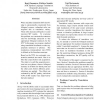639 search results - page 16 / 128 » Semantic Evaluation of Machine Translation |
EACL
2003
ACL Anthology
13 years 10 months ago
2003
ACL Anthology
When machine translation (MT) knowledge is automatically constructed from bilingual corpora, redundant rules are acquired due to translation variety. These rules increase ambiguit...
NAACL
2007
13 years 10 months ago
2007
We compare two pivot strategies for phrase-based statistical machine translation (SMT), namely phrase translation and sentence translation. The phrase translation strategy means t...
CLEF
2001
Springer
14 years 1 months ago
2001
Springer
For the first interactive Cross-Language Evaluation Forum, the Maryland team focused on comparison of term-for-term gloss translation with full machine translation for the documen...
JMLR
2011
13 years 3 months ago
2011
We propose a distance phrase reordering model (DPR) for statistical machine translation (SMT), where the aim is to learn the grammatical rules and context dependent changes using ...
COLING
1992
13 years 9 months ago
1992
Large-scale knowledge-based machine translation requires significant amounts of lexical knowledge in order to map syntactic structures to conceptual structures. This paper present...

